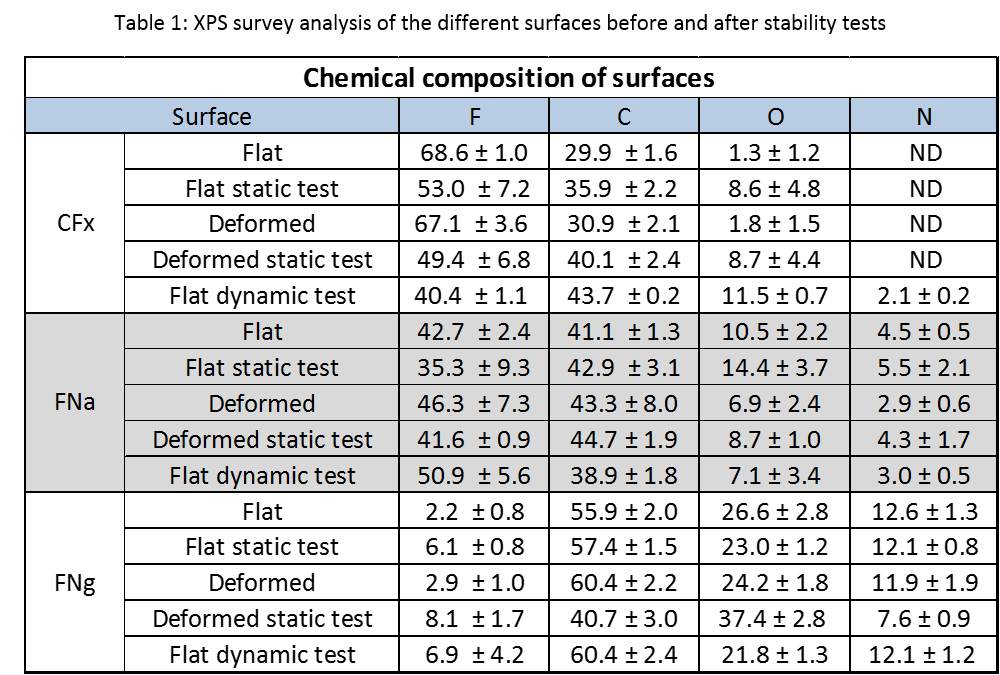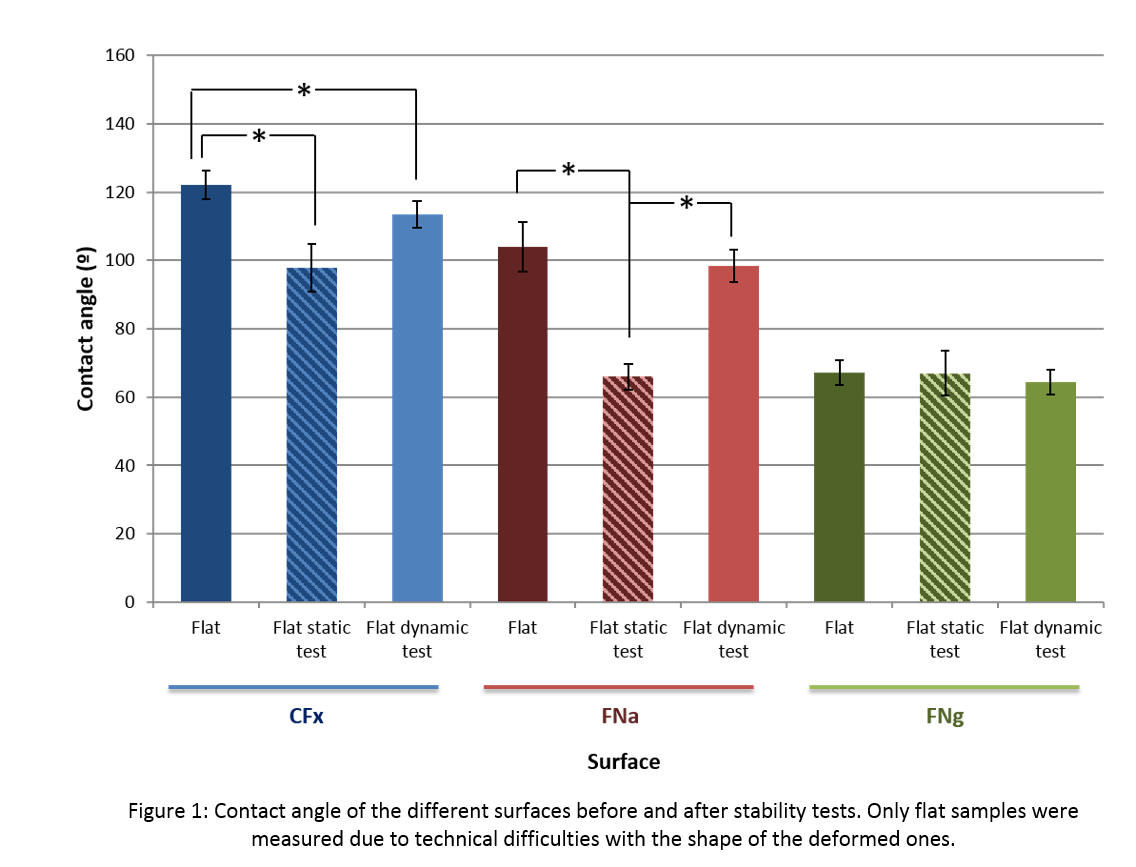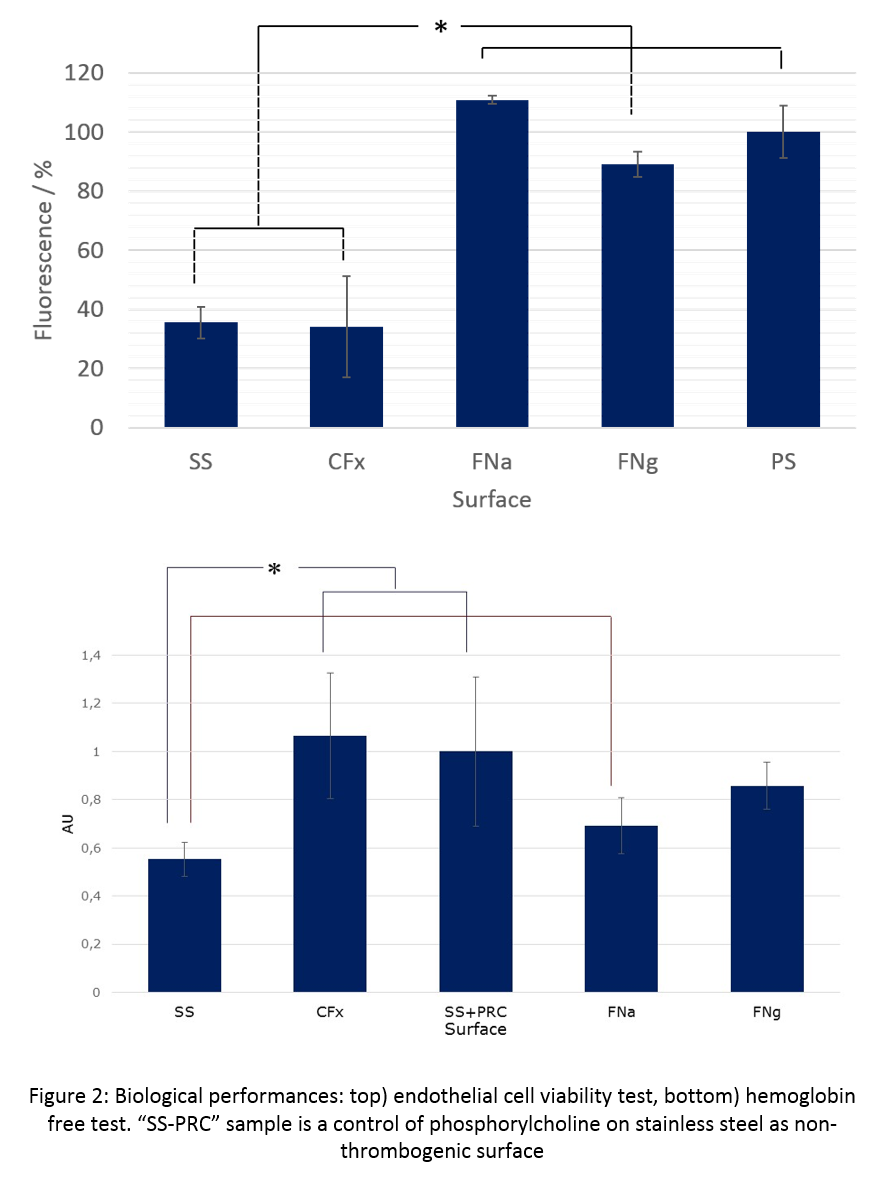Introduction: When a dispositive is implanted in the human body its clinical success is influenced by the first interactions its surface establishes with the surrounding biological tissues and fluids. In the case of cardiovascular applications, endothelialization is still the missed element. Although numerous surfaces modifications based on biomolecules coatings have been reported in the literature, the stability of the coatings is rarely assessed for blood applications involving circulation. This study focuses on the development of a long-term-stable fibronectin (FN) coating on fluorocarbon films (CFx) able to promote endothelial-cell response on cardiovascular devices.
Materials and Methods: Cleaned stainless steel substrates were first coated by a plasma deposition process, leading to CFx films[1]. Afterwards, FN was added following two approaches: adsorption for 30 min at 37 ºC (FNa) or CFx film functionalization followed by FN grafting through glutaric anhydride (FNg)[2]. Deformation tests were performed in order to simulate cardiovascular stenting procedure. Samples were tested under static and dynamic conditions during 7 days in PBS solution[3]. Coating characterizations were performed through X-Ray Photoelectron Spectroscopy, Contact Angle (CA), Atomic Force Microscopy (AFM), Time of Flight Secondary Ion Mass Spectrometry (ToF-SIMS) and immunostaining of FN with polyclonal and monoclonal antibodies. Haemolysis rate (40 min) and endothelial cell viability test (7 days) were completed.
Results and Discussion: XPS survey analysis demonstrated the CFx deposition after plasma process, as well as the presence of both FN coatings (Table 1).

Furthermore, high resolution of C1s evidenced that CF2 bonds from CFx were still detected on FNa whereas for FNg this contribution was no more detectable, but only the picks corresponding to the protein. The CA was very high for CFx film, 122.1 ± 4.2º, and it decreased to 104.2 ± 7.2º and 67.2 ± 3.6º for FNa and FNg respectively (Figure 1).

These results evidenced differences in covering of the CFx film and/or in the protein conformation. However immunostaining assays showed a homogeneous coating for both FNa and FNg samples. Regarding AFM analysis, CFx film presented a Rq and Rsk values of 1 nm and 0.5 respectively, for FNa these values were 4 nm and -1.6, while for FNg were 4.5 nm and 0.6, respectively. ToF-SIMS imaging and depth profiling analysis showed denser coatings of FNg when compared to FNa. After stability tests, both FNa and FNg coatings showed high stability after the deformation process and after static tests. However, after 7 days of dynamic test, FNg presented a more homogeneous and denser coating mainly evidenced by the preservation of the CA, the chemical composition and a decrease of the Rq value. Regarding biological tests (Figure 2), significant improvement on cell viability was detected of both FNa and FNg coatings when compared to the CFx film. FNg showed better hemocompatibility properties than FNa coatings.

Conclusions: Two FN coatings, either adsorbed (FNa) or grafted (FNg), have been characterized by using different techniques and submitted to several stability tests. FN grafted exhibited higher stability and denser coatings than FNa. The pertinence of FNg coating for cardiovascular applications was confirmed also by high endothelial cell viability and hemocompatibility properties.
This work was partially funded by NSERC-Canada, FRQ-NT-Quebec, CFI-Canada, Québec/France Samuel de Champlain Program, Centre de Recherche sur les Matériaux Avancés CERMA-ULaval, Research Center of the CHU de Québec and Wallonie-Bruxelles International. VMM was awarded of a doctoral scholarship from CONACYT – National Council of Science and Technology, Mexico. ToF-SIMS analysis were performed by Céline Noël at the Research Centre in Physics of Matter and Radiation (PMR) in Namur University, Belgium. The authors would like to express their gratitude for their collaboration on the performance of experiments and/or their technical assistance to Laurent Houssiau, Jean-Jacques Pireaux and Stéphane Turgeon.
References:
[1] Haïdopoulos M, Turgeon S, Laroche G, Mantovani D. Chemical and morphological characterization of ultra-thin fluorocarbon plasma-polymer deposition on 316 stainless steel substrates: A first step toward the improvement of the long-term safety of coated-stents. Plasma Process Polym. 2005;2(5):424–40.
[2] Vallières K, Petitclerc É, Laroche G. Covalent grafting of fibronectin onto plasma-treated PTFE: Influence of the conjugation strategy on fibronectin biological activity. Macromol Biosci. 2007;7(5):738–45.
[3] Holvoet S, Chevallier P, Turgeon S, Mantovani D. Toward high-performance coatings for biomedical devices: Study on plasma-deposited fluorocarbon films and ageing in PBS. Materials (Basel). 2010;3(3):1515–32.